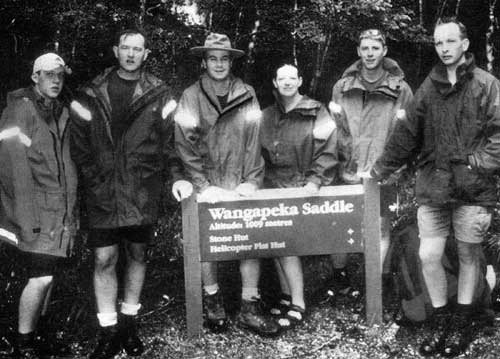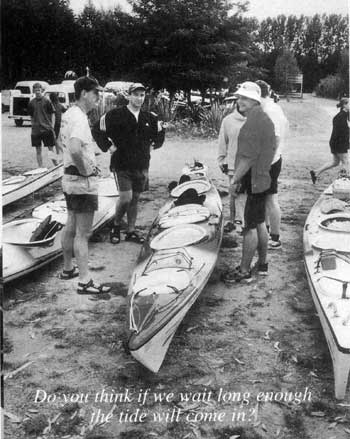During the Maori wars in the Waikato River region of New Zealand in 1863 two members of 94 New Zealand Headquarters Battery won Victoria Crosses at the Battle of Rangiriri.
The Battery was subquently awarded its distinct honour title and it therefore seemed the most appropriate location for the lads to do some adventure training.
The task of organising the trip fell to Capt Andy "the swim cap" Doig a native Kiwi. He took to the task with great vigour, managing to rustle up grants from every possible authority in order to keep individual contributions down to £400.
In all 21 members of the Battery were to take part in what many considered the chance of a lifetime. The actual adventure training was conducted in nthree phases: two hillwalking phases taking seven days in total, followed by a three day kayaking phase.
The hillwalking was led by Capt Phil Stuart with three groups led by Capt Andy Doig, Bdr Nicky (Gwar) Morton and Bdr Darren (the cat) Patton.
Ther are those of us who felt that the flight should have also have been included in the MEL as it took us 29 hours to fly from Frankfurt to LA to auckland to Christchurch, crossing both tropics, the equator and the international date line. We did however, enjoy excellent Air NZ hospitality, some mistaking the word "compimentary" to mean "as much as possible".
After locating our transport we drove to our first staging post, an affluent picture postcard town on the northeren edge of South Island, Nelson.
En route we managed to stop off at hammer springs, a natural hot water spring, for a bathe. On reaching Nelson we were met by a local newspaper reporter and SSgt Mumm from the New Zealand Army.
We were cordially invited to the local Garrison mess to meet the rest of the troops (which numbered only about eight in total - most TA) we attempted to recruit most of them into our Army.
The next day we set out for the start of the first of the track, having persuaded SSgt Mumm and a colleague to secure our vehicles in their camp garages. The Wangapeka Track was to be our first conquest, each group setting off at about 30 minute intervals. The track was nearly 60Km long and if the local information boards were to be believed would take 4-5 days. At the beginning the going was really easy with a good track to follow, however this was the calm before the storm, so to speak.
The track gradually deteriorated and in parts became so difficult that three points of contact were constantly required. As we were loaded with all our provisions for seven days in the field, this meant we had around 50 lbs on our backs. The track was marked with orange direction markers, most of which led us to believe that whoever had set them had a warped sense of humour, causing us to negotiate steep rock faces, dense root-infested vegatation and deep mountail streams, not to mention the numerous wire bridges and other obstacles. We completed the track, though, in record breaking three days but not without a few casualties proving just how difficult it really was.
After some rest in the west coast township of Karamea, the survivors set out on the 70Km Heaphy track, our aim to complete it in four days. Again the start of the trail was good going, but we were not going to be fooled again fearing a repeat of the Wagapeka. We were relieved, though to find that that it was a moderate track and we were able to cover a lot more ground. There was some fantastic scenery and also a surprise for Capt Doig, when one of the National park Rangers we bumped into turned out to be an old school friens of his.
On completion of the trek we found ourselves a 2 hour drive from the sea Kayaking destination, but the well oiled machine found our transport waiting for us and whisked us away to our overnight stop.
The Kyyaking phase was run by Sgt Lee Marshall and was to be done in the Able Tasman National Park, a protected area allowed by the Govern ment to return back to the wild in an experiment to observe the long term effects on the wildlife population. The park has over 30Km of golden coast, with marine life protected out to 10Kms from the shore. Most of us, less the most experianced were put into two man kayaks and after some instruction and safety training were soon on the water.
Sgt Lee Marshall had his hands full trying to keep everyone together, with Capt Phil Stuart and Capt Joe Leahy being the proverbial racing snakes, with the BC Maj Tim (robby williams) Law and Pte Dean Jackson-Smith bringing up the rear, claiming thay had a bigger Kayak than everyone else.
We got to visit seal colony and also saw a stingray hunting in the crystal clear waters close to the shore.
On day two after getting as far north as we wanted in relatively rough seas, we were happy to turn around and come back. This was particulary welcome as the wind had picked up causing some large waves to scare the pants off us. We therefore had to head into a secluded bay and wait it out on the golden sands, with an impromtu game of football.
The third day saw us make good time on the return leg so we put into another bay to practice our capsize drills. All of us went over and carried out the correct drill less for one pair who managed to do it without getting their hair wet. It did not go un-noticed and after we had all recovered our Kyaks and had a rest, we set off again only to turn on WO2 Carl Grostate and Pte Sharon taylor, forcing them to carry out the drill properly.
We were then able to enjoy a few days hard earned R&R in Queenstown, the adventure training capital of the world. This was an oppertuinity none of us were going to miss and the list of activities completed was extensive, with the following to name but a few: quad biking, white water rafting, white water sledging, riding, bungy jumping, dry slope tobogganing and jet boating.
As a group we all throughly enjoyed it with our credit cards glowing as proof.
We wer not finished there though, as we had to travel back up north to Auckland to catch our return flight home. This gave us the opertuinity to see even more of the country and we visited the hot mud pools in Rotorua, the pancake rocks in Punakaika and only the weathers topped us from visiting the wild dolphins nad whales in the town of Kaikoura. Our route also took us to the village of Rangiriri where we visited the battlefield Museum founded by Mr Pat Gaitely, an ex- history teacher. It had been his ambition since retirement to own a museum and when he couldnt find one he started his own. It tells the story of the Waikato River campaign, including the battle of Rangiriri and has been accepted by both the New zealand government and the local Maori tribe as an accurtae and important account of New Zealands history. We took the oppertuinity to conduct a battlefield tour and memmorial service before moving onwards to catch out return flight.
All in all, it was avery successful excercise which not only tested the abitities of the instructors but put us all through a healthy degree of physical and mental stress.
It has left a lasting impression on us all with mutterings of "I,m going there again" and "how much are properties in Wellington" featuring largely in conversations on the plane.
We all hope that this could turn into a regular event in order to strenghen the Battery ties with its heritage, especially with the 150th Anniversary looming in 2013.......

One of the walking groups reaches the first saddle on the Wangapeka Track
(L_R)
Gnr Spike Algie - Sgt Orchard - Capt Andy Doig - Gnr Sam King
Pte Dean Jackson Smith - Maj Tim Law (BC)

Comment says - IF WE WAIT LONG ENOUGH WILL THE TIDE COME IN ?